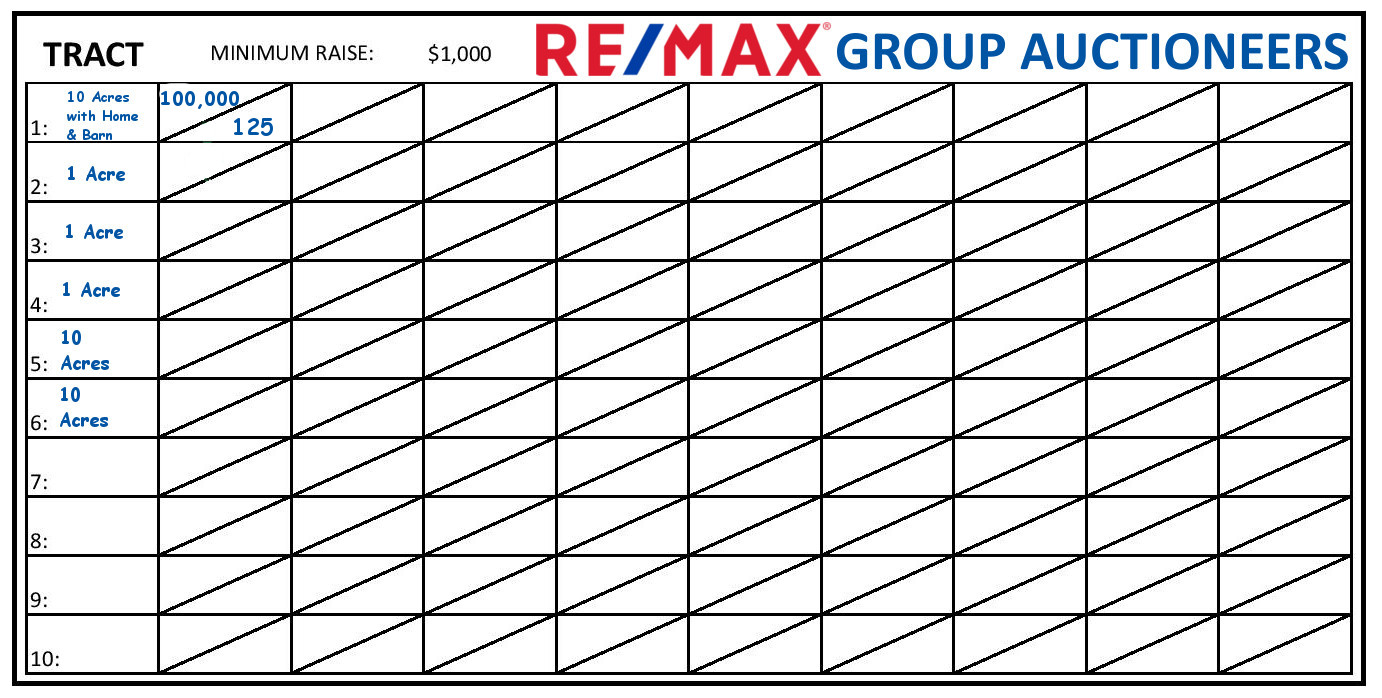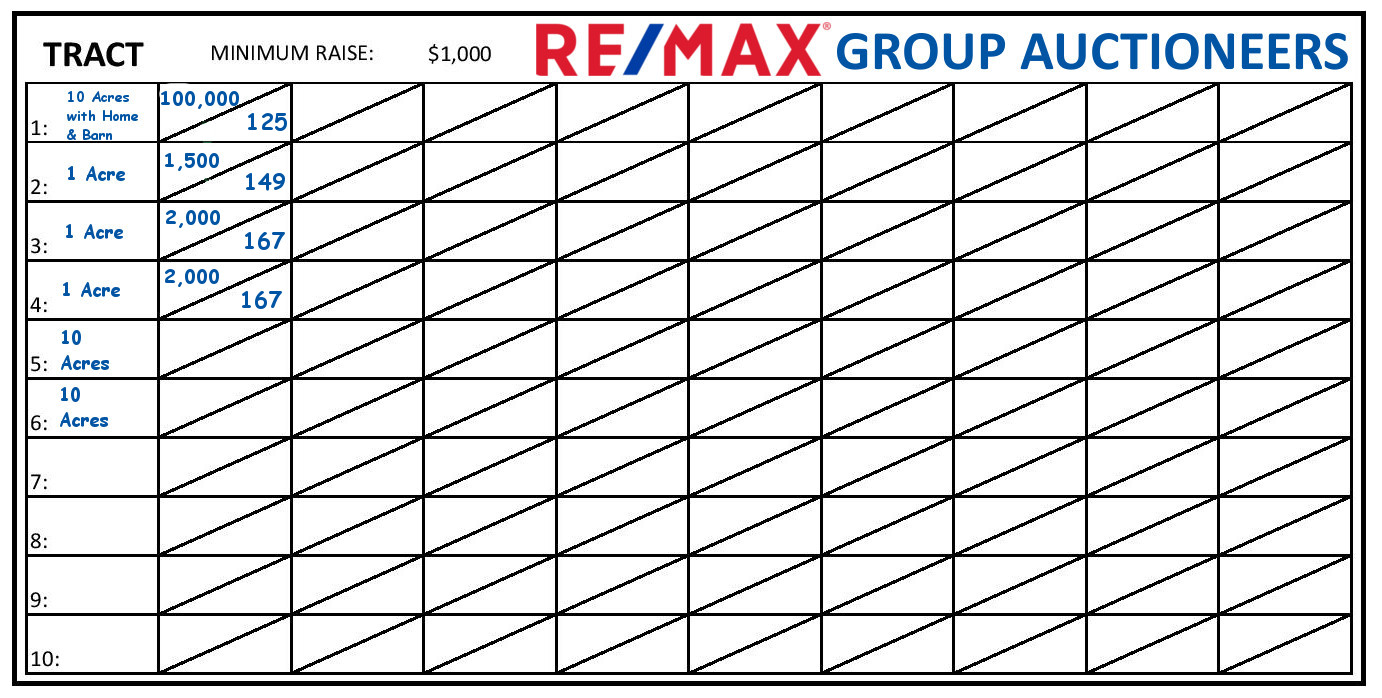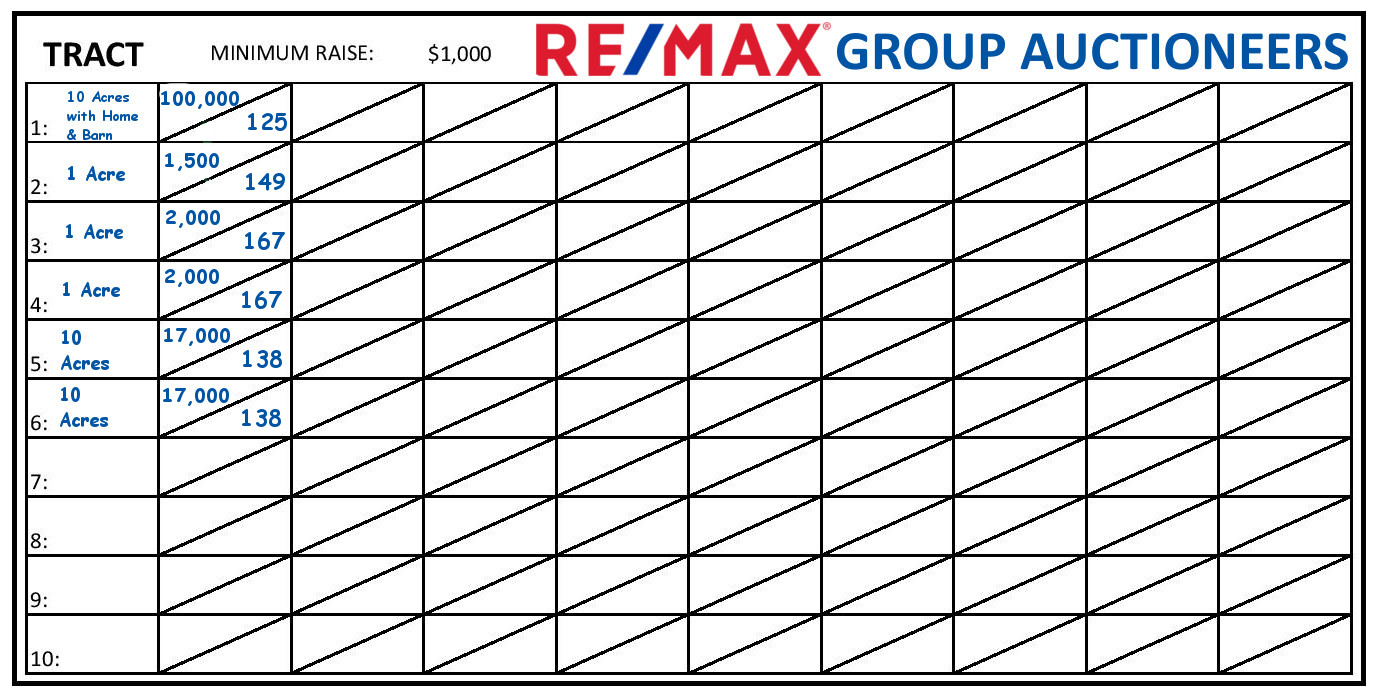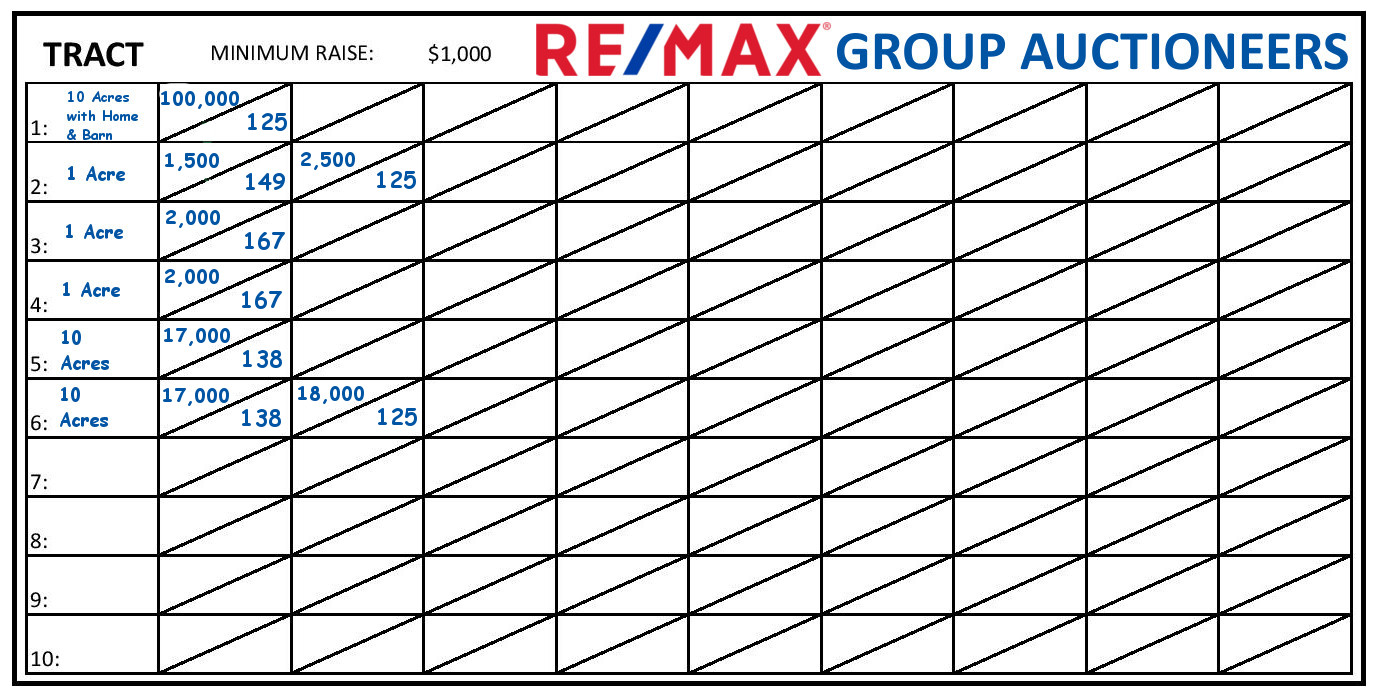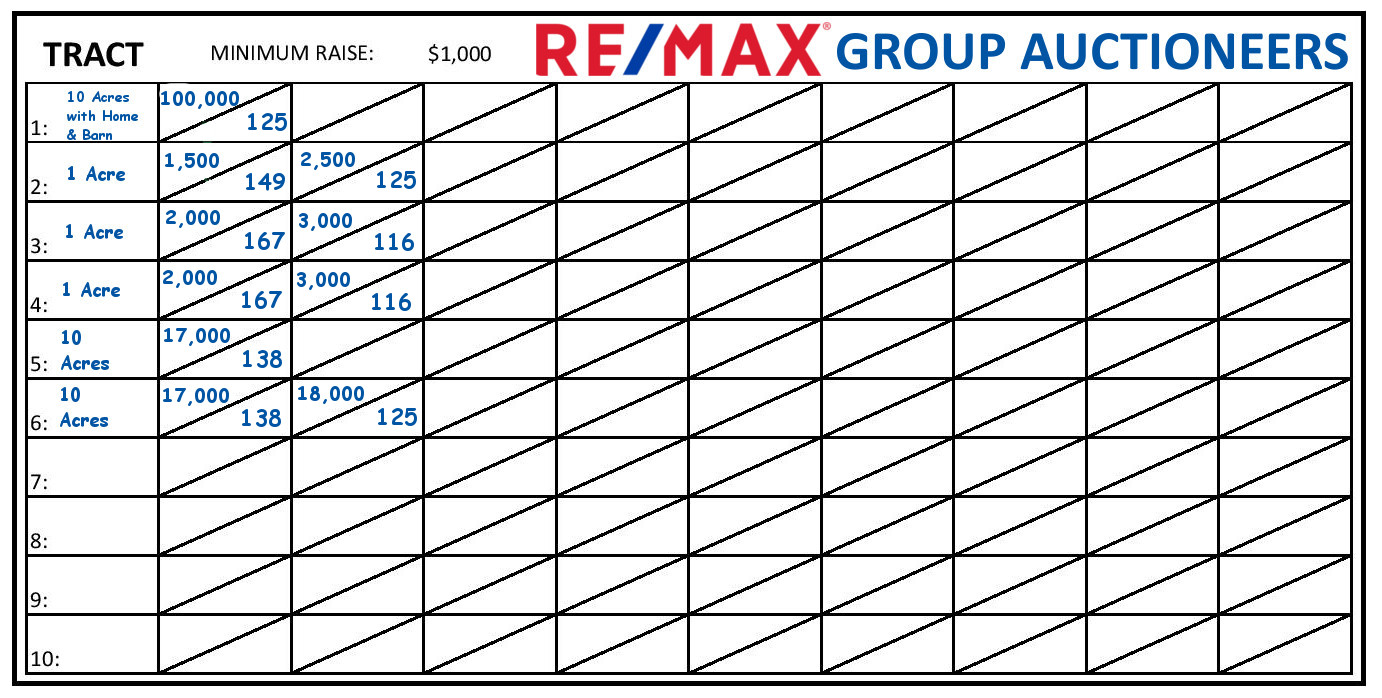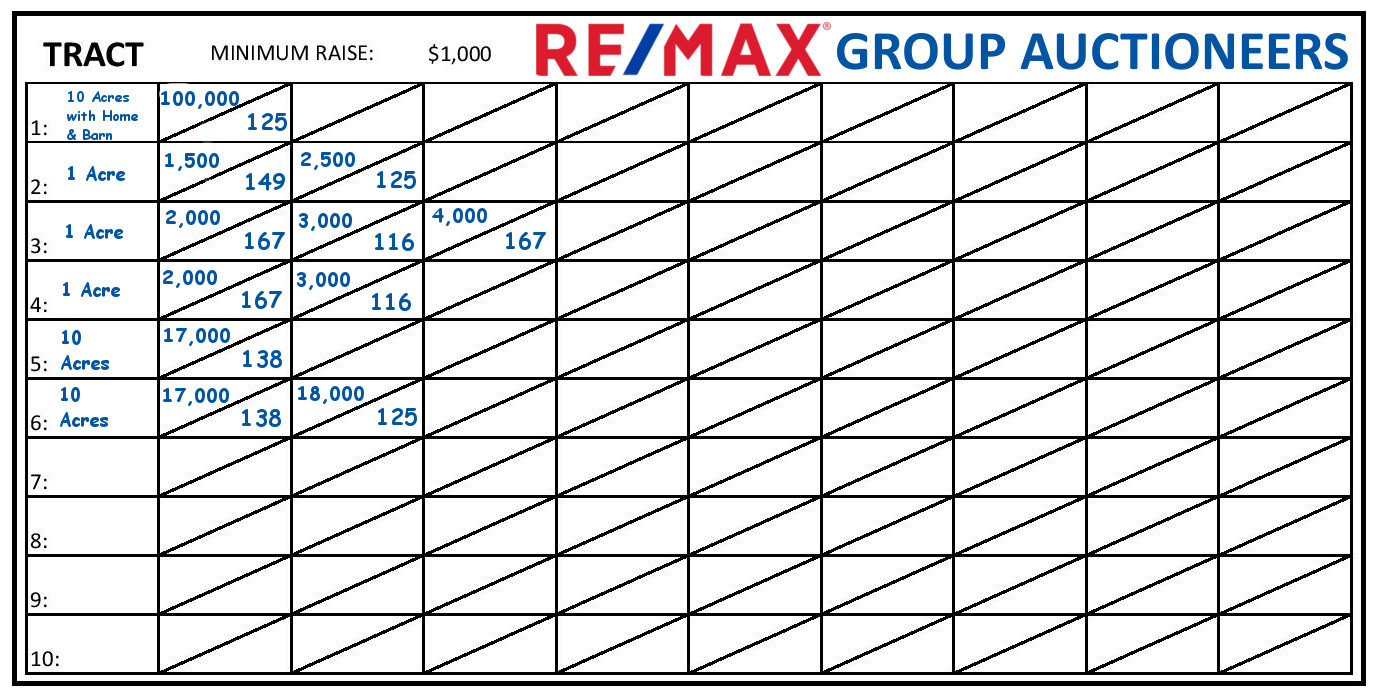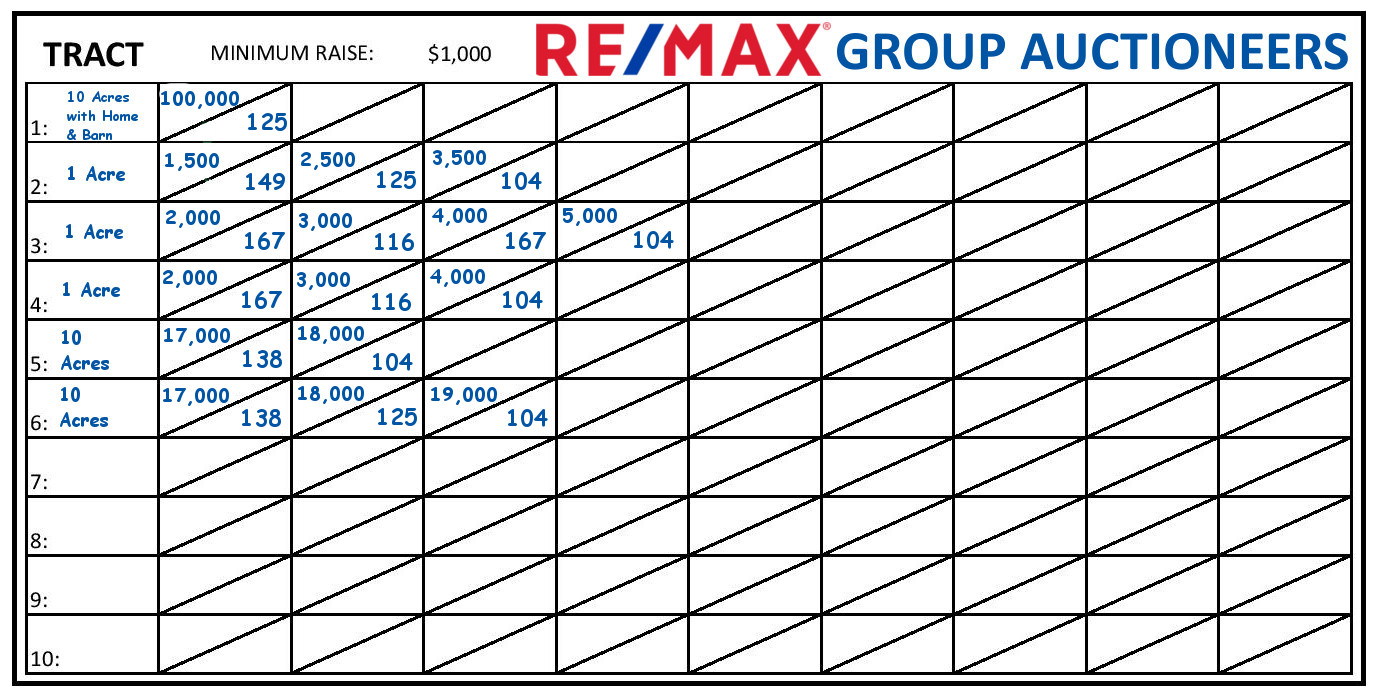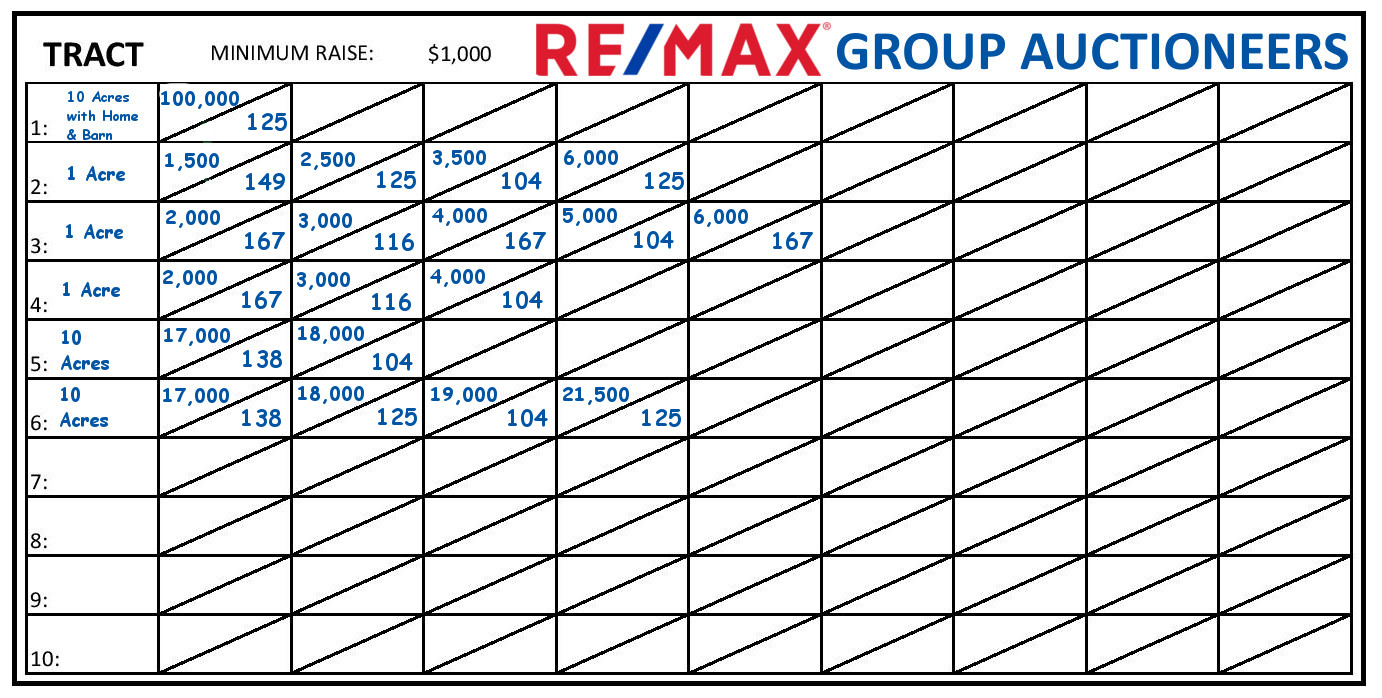A Multi-Parcel Auction is an auction where the property can be sold either as a whole or in tracts. This type of auction benefits both the buyer and the seller. Buyers can bid on only the tracts of land they are interested in. This generally will attract more buyers, as people can buy land that is suited to their individual needs. Many people cannot afford a $500,000 farm (or want to try and maintain it), but can afford a $5,000 slice of it.
Multi-Par Auctions


Multi-Par Auctions bring in larger crowds because the tracts are more affordable. This helps the seller because each individual tract can bring fair market value, and in most cases, more than market value.
Sellers don’t have to wait for that one big spender to come along. They can sell large acreages all at one time without needing just one buyer.

The saying goes, “The whole is greater than the sum of its parts”. Aristotle clearly had never seen a Multi-Par Auction when he made that statement. We have seen time and again that the Multi-Par Auction method consistently brings in more dollars than selling a large area of land conventionally.

A Multi-Parcel Auction is an auction where the property can be sold either as a whole or in tracts. This type of auction benefits both the buyer and the seller. Buyers can bid on only the tracts of land they are interested in. This generally will attract more buyers, as people can buy land that is suited to their individual needs. Many people cannot afford a $500,000 farm (or want to try and maintain it), but can afford a $5,000 slice of it.
Multi-Par Auctions bring in larger crowds because the tracts are more affordable. This helps the seller because each individual tract can bring fair market value, and in most cases, more than market value.
The saying goes, “The whole is greater than the sum of its parts”. Aristotle clearly had never seen a Multi-Par Auction when he made that statement. We have seen time and again that the Multi-Par Auction method consistently brings in more dollars than selling a large area of land conventionally.
Sellers don’t have to wait for that one big spender to come along. They can sell large acreages all at one time without needing just one buyer.
The Multi-Par Auction Board
The Multi-Par Auction board can seem intimidating at first glance. It is actually a very easy and organized way for buyers to know where the bidding is at any given time.
The board is broken up into a few parts:
-
The first column lists the tract numbers on individual rows as well as their size and any other features that should be noted (house, barn, etc.).
-
The second column is the first round of bidding.
-
The third, fourth, fifth, etc. columns indicate round 2.
-
The columns are divided diagonally into 2 sections each. One section is for the winning bid for that round. The other section is the corresponding winning bidder number.
In addition to the Multi-Par Board, there will generally be a large copy of the plats. You will also most likely receive a personal copy of the plats along with a bidding worksheet to help you keep track of the bidding compared to your goals.
The Multi-Par Auction Board
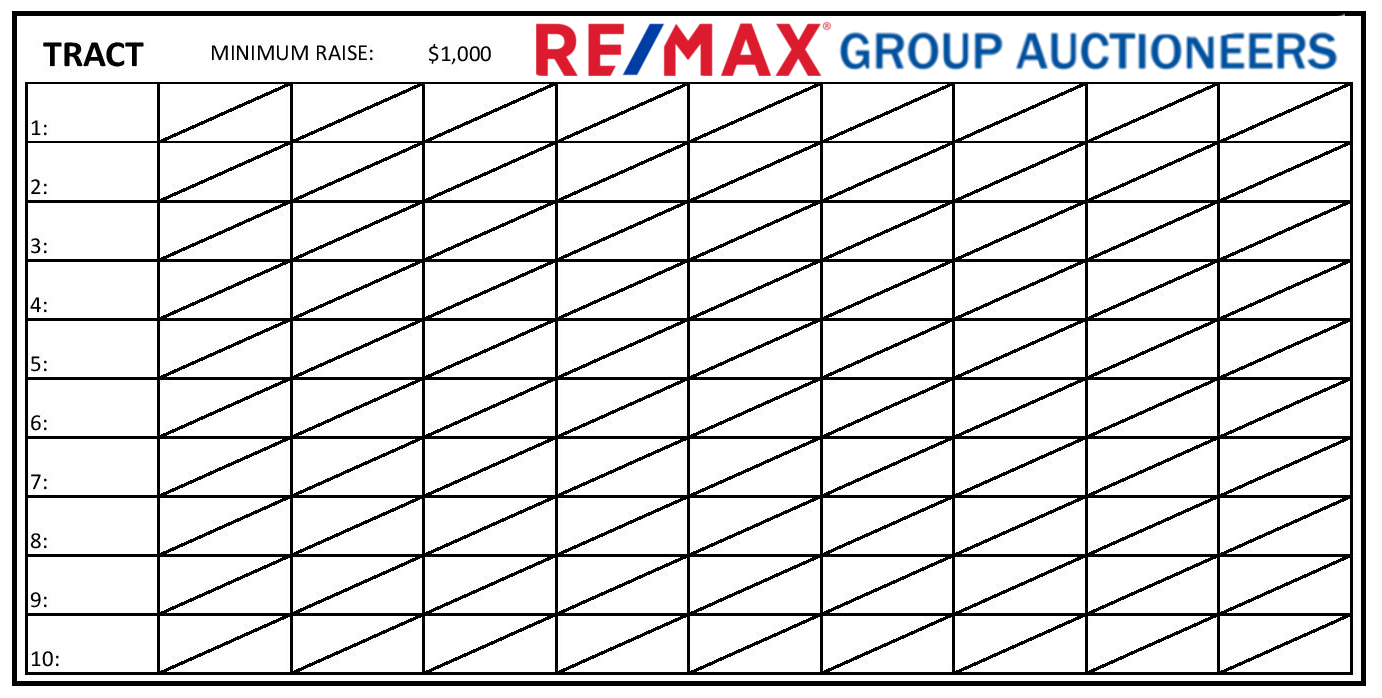
The Multi-Par Auction board can seem intimidating at first glance. It is actually a very easy and organized way for buyers to know where the bidding is at any given time.
The board is broken up into a few parts.
-
The first column lists the tract numbers on individual rows as well as their size and any other features that should be noted (house, barn, etc.)
-
The second column is the first round of bidding.
-
The third, fourth, fifth, etc. columns indicate round 2.
-
The columns are divided diagonally into 2 sections each. One section is for the winning bid for that round. The other section is the corresponding winning bidder number.

In addition to the Multi-Par Board, there will generally be a large copy of the plats. You will also most likely receive a personal copy of the plats along with a bidding worksheet to help you keep track of the bidding compared to your goals.
Multi-Par Auction Bidding
Bidding for Multi-Par Auctions can be done in a few different ways.

By the dollar amount
This is generally the method used when there is a structure on the tract that is being auctioned off. In this case, the bidding is done just as in any other auction. The price you bid is the going high bid price.

By the acre
Most tracts that are just land with no structures on them are done this way. You bid the amount you want to pay per acre. The winning bid times the number of acres in the tract will be the high bid price for that tract. So if you are bidding on a 10 acre lot and you want to pay $10,000, then you will bid $1,000.

Choice
In many cases, there are several tracts that are the same or similar in size. These can be offered as “Choice”. So if tracts 2 through 4 are all 10 acres and they are offered as “choice by the acre”, the winning bidder for tract 2 can take just tract 2, or they can take any combination of the 3 choice lots at their high bid price.
Round 1
-
The bidding for round one begins in the standard auction format.
-
The auctioneer will begin with the first tract.
-
He will use the well known auction chant to take bids and announce the high bid, next bid, and eventual winner of that tract (or tracts if “Choice”).
-
This process continues until all the individual tracts have a high bidder in round 1.
Round 2
-
Round 2 of the Multi-Par Auction is not done in the conventional auction chant style. Instead, bidders can give their bids to the auctioneer or ringmen as they decide they want to raise on any of the tracts.
-
As raises are brought up or called out, the board is updated with the new bidder number and amount.
-
In round 2, all bids are by the dollar amount. So the tract in round 1 that was bid at $1,000 per acre ($10,000 winning bid) is being raised using the total amount.
-
Raises are generally made in $1,000 increments. Some auctions have different raise amounts, but $1,000 is pretty standard.
-
Round 2 is complete when there are no more bids and the Auctioneer calls SOLD!
A couple of things to note
Whole Board bids are accepted at any time. If at any point you wish to make a bid on the entire board, you may do so. At the end of the auction, the highest bid wins, whether it is the whole board or a combination of all the individual tract bids.
In most cases there is a 10% buyers premium added to the winning bid to make the final sale price. Once the final sale price has been determined, the winning bidder(s) are required to put a 15% down payment on the property. This is due the day of the auction.
Once all bids have been received, the auctioneer will call SOLD and read off the winning bidder(s). Each winning bidder will fill out a Uniform Sales and Purchasing Contract along with the Property Owner and Auctioneer / Broker.
Let's Run Through a Mock Auction
The first thing you will do upon arrival is fill out a registration card for the Multi-Par Auction and receive your bidder number. Registration is free for all of our auctions unless specifically stated.
You will also receive a flyer with information about the property as well as a list of the tracts and their corresponding size and tract number.
When the auction is ready to begin, the auctioneer will go over the process for the auction. Each auction is unique in its own way, so going over the process now ensures all parties are on the same page.

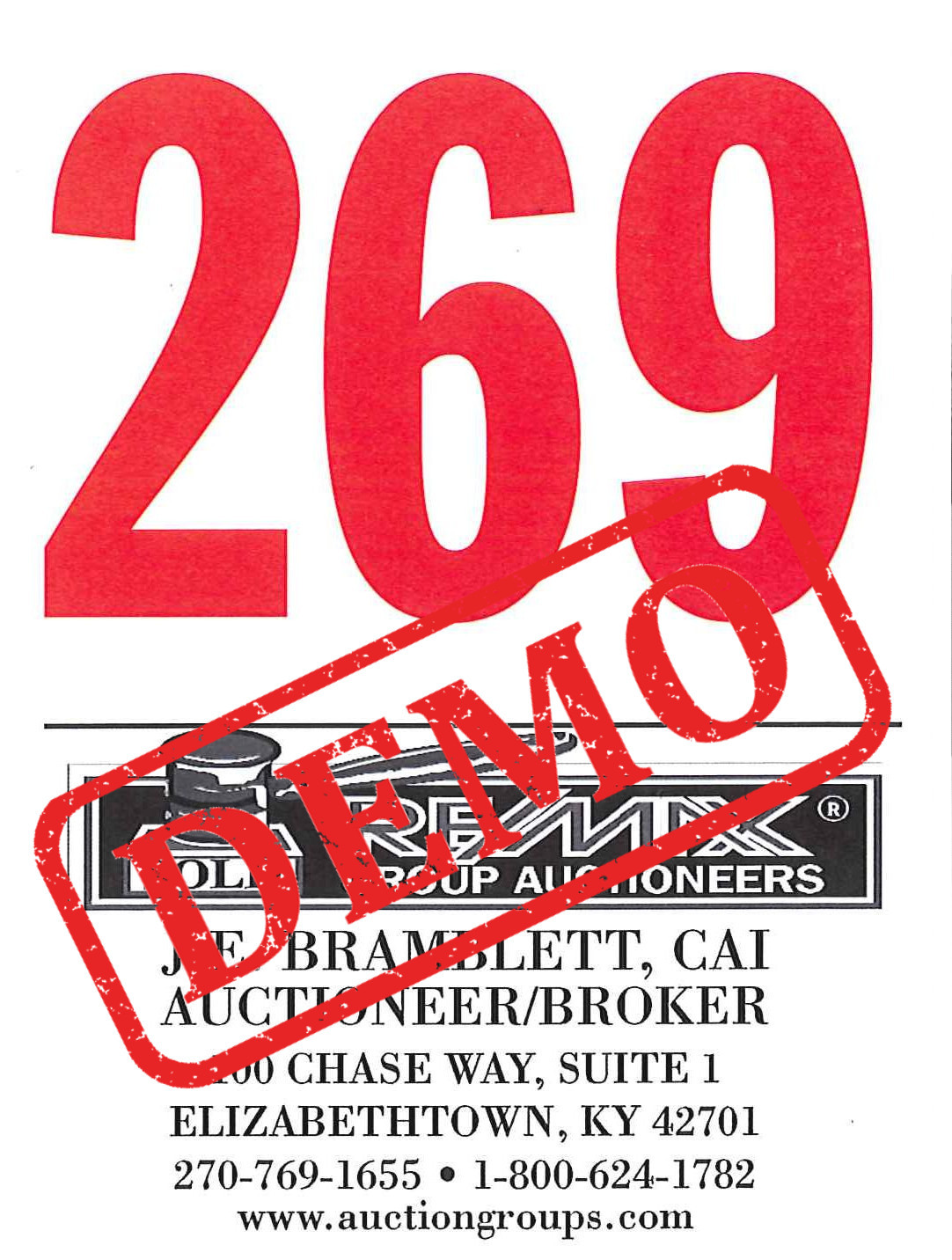

Round 1
Tract 1
The first tract in our example has 10 acres and a home on it. Because it has a home on it, this tract will be auctioned by the dollar amount. This means that you will be calling out the actual dollar amount you would like to be the high bidder on this tract (keeping in mind the 10% buyers premium). In our example, the high bid is $100,000 and was placed by bidder 125

Round 1
Tracts 2, 3, 4
The next 3 tracts will be sold as “Choice”, by the acre. This means the auctioneer will start the bidding in the normal fashion. In this instance, the bids will be placed in the amounts by the acre. If the winning bid here is $2,000, then the price of the tract will be $2,000 (plus buyers premium). The winning bidder here also has the choice of the 3 tracts. They can take one, two, or all three at that price per acre. In our example, bidder 167 wants tracts 3 and 4.

Round 1
Tract 2
Since the previous winning bidder did not take all 3 tracts, the bidding starts fresh on the last remaining tract in that set. The auctioneer will start taking bids until there is a high bidder. In this case it is tract 2 and the winning bidder is number 149. Their final bid was $1,500. So we add them to the board.

Round 1
Tracts 5 & 6
Tracts 5 and 6 are larger tracts and will also be sold as “Choice” by the acre. The bidding starts as usual until a high bid is reached. The winning bidder here is number 138 and they choose to take both tracts for their winning bid of $1,700 per acre. This makes each tract $17,000 on the board ($1,700 x 10 acres per tract).
With all tracts on the board having a high bid, this completes round 1 of the Multi-Par Auction. The auctioneer will then proceed to go over the rules for round two and allow the bidding to start.
Important Note*
If you are only looking to purchase one tract at this Multi-Par Auction, you want to make sure you are the high bidder for that tract in round 1. The general rules for round two call for any raises to be done in increments of 2 or more tracts at a minimum of $1,000 per tract. The benefit of being in round 1 of the Multi-Par Auction is that you have the right to protect your single tract to the end.
Round 2
Open Raises

Another key difference between rounds 1 and 2 is that round 2 is not done in the traditional auction style with the auctioneer using the chant. Instead, bidders can bring their raises to the ringmen or the auctioneer in any order.
The bidding in round 2 of a Multi-Par Auction must be done in increments of 2 tracts with a minimum raise of $1,000 per tract. These rules vary by auction, sometimes the minimum raise is $500. The minimum number of tracts required to raise may be more than 2. The auctioneer will go through the rules for round two before the auction starts as well as at the start of round 2.

Round 2
Raises Continue
Bidders 125 and 167 won’t give up. They raise the bids on the tracts they want again. This time Bidder 125 raises both tracts 2 and 6, but they raise them by $2,500 in order to try and keep other bidders from raising again. Bidder 167 decides to play it safe and only raise by $1,000.
This type of raise bidding continues until there are no more raises. Once there are no more raises, the auctioneer will tally the high bids for each tract. That total will be compared against any whole board bids that were placed during the auction. The higher of the two totals wins.
The auctioneer will call sold and that ends the Multi-Par Auction. Winning bidders will sign their high bid acknowledgement form(s) and head over to the auction trailer to complete the sale.
In our example, if it were to have ended where we left off, there were no whole board bids, so the winners are as follows:
-
Tract 1: Bidder 125 – $100,000
-
Tract 2: Bidder 125 – $6,000
-
Tract 3: Bidder 167 – $6,000
-
Tract 4: Bidder 104 – $4,000
-
Tract 5: Bidder 104 – $18,000
-
Tract 6: Bidder 125 – $21,500
Total of the high bids – $155,500
Multi-Par Auction
Payment and Contract
Once the high bids have been established, the winning bidders must complete a Uniform Sales and Purchase Agreement with the auctioneer and the seller. A 15% down payment is collected the day of the sale. The down payment is figured based on the final sale price plus the 10% buyers premium and any applicable taxes. You are required to close on the property within 30 days of the auction.
As an example, a real estate auction with a high bid of $100,000 has a final sale price of $110,000.
This means the down payment will be $16,500.
100,000 + 10% buyers premium (10,000) = 110,000 final sale price
110,000 * 15% = 16,500 down payment
Every Multi-Par Auction has its own terms and conditions stating the fees and down payment requirements. Before bidding at any auction, make sure you are aware of the requirements in advance so you can prepare accordingly.
Send Me New Auctions!
Fill out the form below to be added to our exclusive auction notification list. You will be notified of all of our upcoming auctions.





